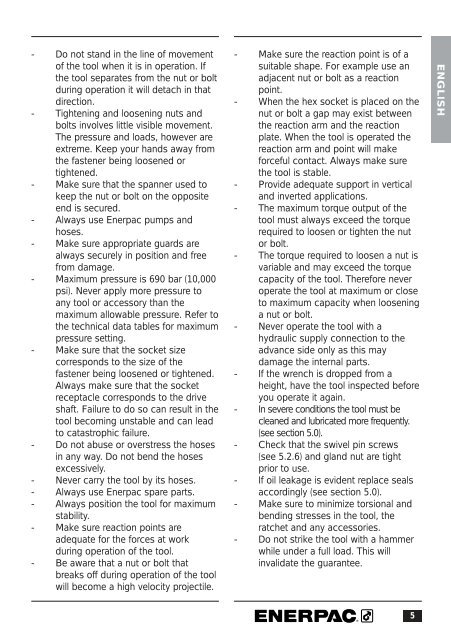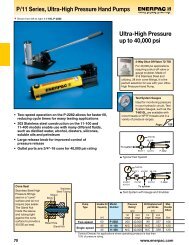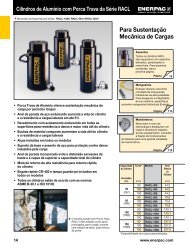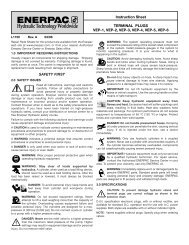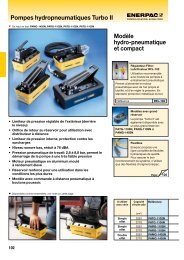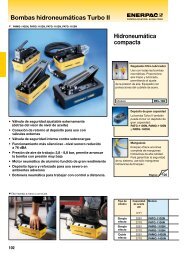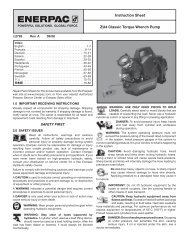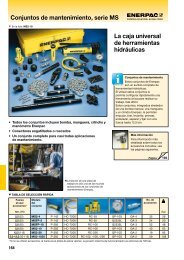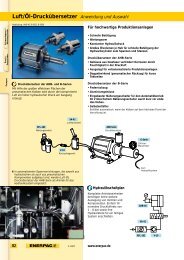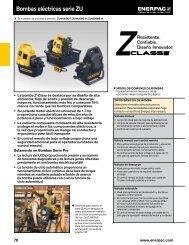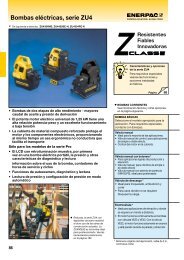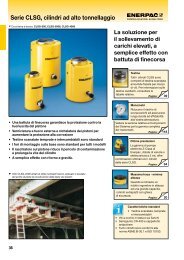Hydraulic Technology Worldwide - Enerpac
Hydraulic Technology Worldwide - Enerpac
Hydraulic Technology Worldwide - Enerpac
You also want an ePaper? Increase the reach of your titles
YUMPU automatically turns print PDFs into web optimized ePapers that Google loves.
- Do not stand in the line of movement<br />
of the tool when it is in operation. If<br />
the tool separates from the nut or bolt<br />
during operation it will detach in that<br />
direction.<br />
- Tightening and loosening nuts and<br />
bolts involves little visible movement.<br />
The pressure and loads, however are<br />
extreme. Keep your hands away from<br />
the fastener being loosened or<br />
tightened.<br />
- Make sure that the spanner used to<br />
keep the nut or bolt on the opposite<br />
end is secured.<br />
- Always use <strong>Enerpac</strong> pumps and<br />
hoses.<br />
- Make sure appropriate guards are<br />
always securely in position and free<br />
from damage.<br />
- Maximum pressure is 690 bar (10,000<br />
psi). Never apply more pressure to<br />
any tool or accessory than the<br />
maximum allowable pressure. Refer to<br />
the technical data tables for maximum<br />
pressure setting.<br />
- Make sure that the socket size<br />
corresponds to the size of the<br />
fastener being loosened or tightened.<br />
Always make sure that the socket<br />
receptacle corresponds to the drive<br />
shaft. Failure to do so can result in the<br />
tool becoming unstable and can lead<br />
to catastrophic failure.<br />
- Do not abuse or overstress the hoses<br />
in any way. Do not bend the hoses<br />
excessively.<br />
- Never carry the tool by its hoses.<br />
- Always use <strong>Enerpac</strong> spare parts.<br />
- Always position the tool for maximum<br />
stability.<br />
- Make sure reaction points are<br />
adequate for the forces at work<br />
during operation of the tool.<br />
- Be aware that a nut or bolt that<br />
breaks off during operation of the tool<br />
will become a high velocity projectile.<br />
- Make sure the reaction point is of a<br />
suitable shape. For example use an<br />
adjacent nut or bolt as a reaction<br />
point.<br />
- When the hex socket is placed on the<br />
nut or bolt a gap may exist between<br />
the reaction arm and the reaction<br />
plate. When the tool is operated the<br />
reaction arm and point will make<br />
forceful contact. Always make sure<br />
the tool is stable.<br />
- Provide adequate support in vertical<br />
and inverted applications.<br />
- The maximum torque output of the<br />
tool must always exceed the torque<br />
required to loosen or tighten the nut<br />
or bolt.<br />
- The torque required to loosen a nut is<br />
variable and may exceed the torque<br />
capacity of the tool. Therefore never<br />
operate the tool at maximum or close<br />
to maximum capacity when loosening<br />
a nut or bolt.<br />
- Never operate the tool with a<br />
hydraulic supply connection to the<br />
advance side only as this may<br />
damage the internal parts.<br />
- If the wrench is dropped from a<br />
height, have the tool inspected before<br />
you operate it again.<br />
- In severe conditions the tool must be<br />
cleaned and lubricated more frequently.<br />
(see section 5.0).<br />
- Check that the swivel pin screws<br />
(see 5.2.6) and gland nut are tight<br />
prior to use.<br />
- If oil leakage is evident replace seals<br />
accordingly (see section 5.0).<br />
- Make sure to minimize torsional and<br />
bending stresses in the tool, the<br />
ratchet and any accessories.<br />
- Do not strike the tool with a hammer<br />
while under a full load. This will<br />
invalidate the guarantee.<br />
5<br />
ENGLISH


